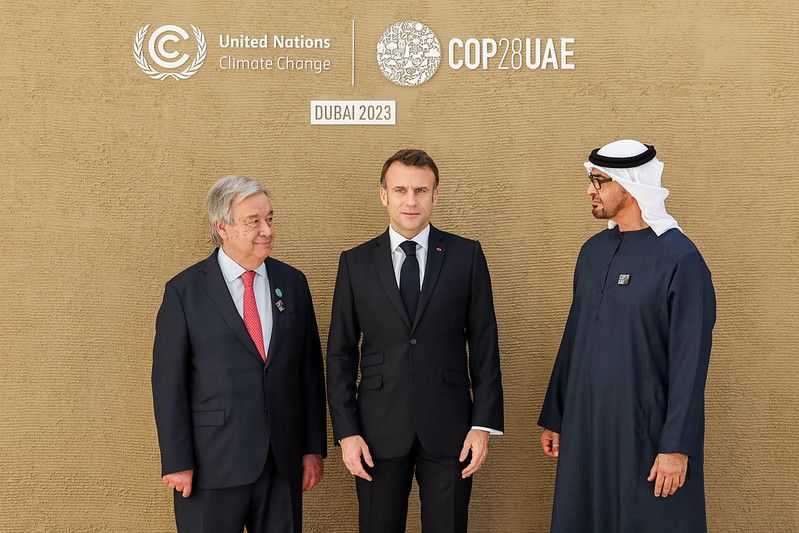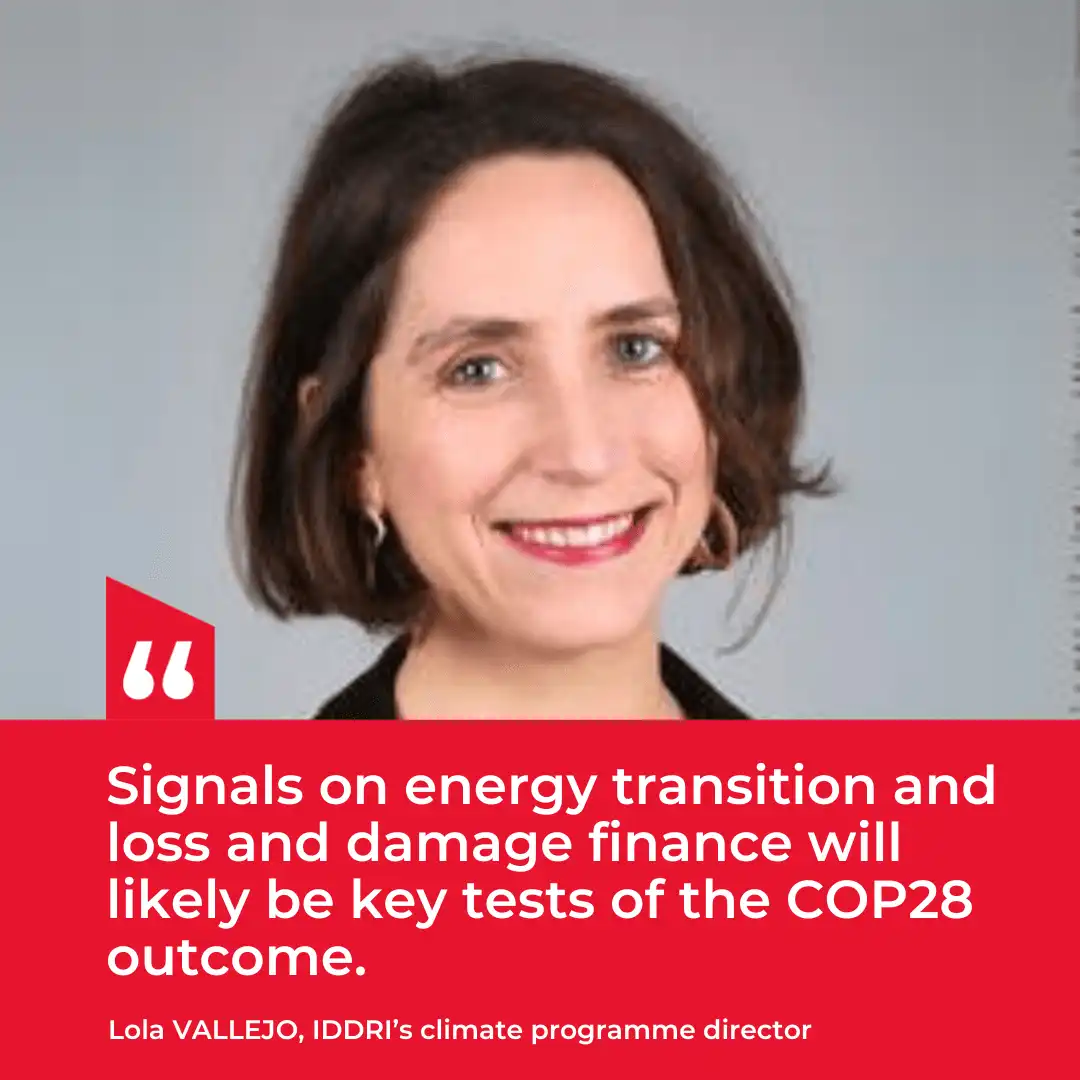Home>Analysis: COP28 in Dubai, the moment of truth ?

01.12.2023
Analysis: COP28 in Dubai, the moment of truth ?
The 28th Conference of the Parties (COP28) for the United Nations Framework Convention on Climate Change (UNFCCC) is taking place in Dubai (United Arab Emirates) from 30 November to 12 December.
Sciences Po's researchers will be offering their specialised take on the event throughout its course: Charlotte Halpern from the newly launched Institute for Environmental Transformations, Centre for European Studies and Comparative Politics (CEE) and the Laboratory for Interdisciplinary Evaluation of Public Policies (LIEPP), Richard Balme and Théodore Tallent from the CEE, Carola Klöck from the Centre for International Studies (CERI), Valeria de los Casares from the Paris School of International Affairs (PSIA) and the European Chair for Sustainable Development and Climate Transition, Lola Vallejo and Sébastien Treyer from the IDDRI (a think tank which facilitates the transition towards sustainable development)…
Read right now the article from Lola Vallejo, IDDRI’s climate programme director, initially published on IDDRI's website.
In a tense geopolitical context, COP28 will need to both assess climate action’s progress and gaps to date, as well as agree on forward-looking signals to spur countries on action and support, and meet the Paris Agreement long-term goals (mitigation, adaptation, finance). Signals on energy transition, particularly the phasing-out of fossil fuels, as well as delivering on the high expectations created at Sharm-el-Sheikh’s COP27 on loss and damage finance will likely be key tests of its outcome.
Global Stocktake
The incoming COP President and chairman of Abu Dhabi National Oil Company (ADNOC) and Masdar (a public renewable & hydrogen development company), Sultan Al Jaber, set out in Letter to Parties in July, October and November the UAE’s progress, priorities and expectations towards COP28. The Global Stocktake looms large among the expected negotiated outcomes. As per the Paris Agreement dynamic of ratcheting up ambition along five-year cycles, it aims to assess progress and inform future action on all the pillars of climate action, from mitigation, adaptation and loss & damage, ahead of the enhancement Nationally Determined Contributions due in 2025.
COP28 will have to condense in a decision a mammoth process two years in the making, with over 1,000 supporting documents submitted, 3 technical dialogues drawing hundreds of experts and practitioners. The synthesis report of the technical phase offers a good basis, having managed to distil it all in 17 key messages. Unsurprisingly, the report acknowledges a “glass half-full/empty” situation: in creating a universal framework around common goals and targets, the Paris Agreement has delivered action on many fronts - yet much more is needed towards system transformations anchored in equity, both from Governments and non-Parties alike. The mitigation section emphasises “the need for transformations across all sectors and contexts, including scaling up renewable energy while phasing out all unabated fossil fuels, ending deforestation, reducing non-CO2 emissions and implementing both supply- and demand-side measures”, in a nod to the findings of the IPCC 6th Assessment Synthesis Report on opportunities for near-term action (Figure SPM.7).
On adaptation, the report emphasises that “most observed adaptation efforts are fragmented, incremental, sector-specific and unequally distributed across regions” and that further efforts must be “informed and driven by local contexts, populations and priorities”. And comprehensive risk management and the need to “rapidly scale up” support for adaptation and loss & damage “from expanded and innovative sources” feature as well. On support, international public finance is dubbed a “prime enabler” that needs to be “strategically deploy[ed]”, alongside “making all financial flows-international and domestic, public and private - consistent with a pathway towards low GHG emissions and climate-resilient development”. The necessity of strengthening international cooperation cuts across all themes.
Towards an Energy Package?
By design, the Global Stocktake is better-suited to reach a “balanced” outcome that addresses all countries’ priorities in a decision, as everything is under the microscope - as opposed to the 2018 Talanoa dialogue which focused primarily on mitigation. However, the UAE has made “fast tracking the energy transition and slashing emissions before 2030” one of its four key priorities, and tasked the International Energy Agency supported by IRENA to convene ministers towards an outcome. The IEA’s World Energy Outlook 2023 and update to its Net Zero Report highlight five actions needed to 2030 to keep 1.5°C alive:
- Tripling of the renewables capacity installed;
- Doubling energy intensity improvements;
- An orderly drop in fossil fuel use of 25% by 2030, and 95% by 2050;
- A 75% cut in methane emissions from fossil fuels;
- A tripling of clean energy spending in emerging and developing economies.
These have mostly been echoed in various declarations throughout the year albeit sometimes in looser, less quantified terms, including the G20 New Delhi Leaders’ Declaration and its focus on low-cost energy transition finance, the International Climate and Energy Summit (Madrid) or the EU Environment Council conclusions and its precautionary approach on the role of abatement technologies. The COP28 presidency is also working on a voluntary pledge focusing only on the renewable and energy efficiency goals.
On all topics, a key question will be how to ensure that momentum is not lost beyond the Global Stocktake declaration so that the conditions for turning these collective signals into a reality are followed through in appropriate forums. This is all the more important as COP28 takes place in a challenging context for multilateralism, with the wars in Ukraine and in the Middle East having a direct impact on energy transition. Process-wise, tensions between the EU and Russia mean that the UNFCCC has no candidate for COP29 incoming presidency, originally due to take place in Central and Eastern Europe in 2024.
There are three other pieces of the “negotiated” agreements expected on adaptation, mitigation and loss and damage. Finance and the Action Agenda will also feature heavily.
Global Goal on Adaptation
The two-year Glasgow-Sharm El Sheikh work programme on the Global Goal on Adaptation is due to conclude by adopting a “framework” for adaptation, anchored in the various phases of the policy cycle (risk assessment, planning, implementation, evaluation), priority areas, and cross-cutting considerations. For adaptation, ”classical" quantitative indicator-based methods are limited by difficulties in identifying both indicators that are relevant and comparable across countries, and sufficient underlying data. That makes defining a “North star” for action (equivalent to the 1.5°C goal) complex, and assessing progress against it difficult. IDDRI is suggesting an alternative method based on expert judgment and informed by a set of key questions paired with a scoring system, whilst allowing for local to national circumstances to be reflected.
First Mitigation decision
The Sharm el Sheikh Mitigation Work Programme (MWP) established at COP27 focused in its first year on accelerating the just energy transition, through two Global Dialogues on power and transport systems. COP28 should see its first decision adopted, following an intense agenda fight in Bonn in June this year. By design, the work programme is set up to encourage cooperation amongst countries and international experts in specific areas, and to link mitigation and investment.
This year’s investment-focused events spurred coordination amongst key initiatives aimed at supporting NDC implementation, but also highlighted structural issues such as the fast acceleration of clean investments globally, and the need to increase them in emerging and developing economies specifically. Beyond COP28, it can be a process under which to take forward the mitigation outcomes of the Global Stocktake, and contribute to, for instance, mobilising investment opportunities with a regional lens, as per Regional Finance Forums led by High Level Champions.
Loss & Damage
COP27 in Sharm-el-Sheikh created high expectations for countries to actually deliver within a year’s time new funding arrangements, including establishing a new fund, to address loss and damage, and set up the Transitional Committee to deliver them, as had been done when setting up the Green Climate Fund. At their fifth session, the Committee agreed on a proposal that may be amended or adopted in Dubai.
It’s a fragile equilibrium, whereby the Fund will be hosted by the World Bank for four years, but with a strong Board with a majority of developing countries in charge of defining eligibility criteria. Developed countries are urged to contribute, while a board seat is implicitly reserved for developing countries with the capacity to contribute, and the door is left open for philanthropies or innovative sources, as explored recently by UNCTAD and IDDRI.
Finance
“Deliver old promises” on finance is another stated priority for UAE. Updating the 2022 Delivery Plan Progress Report could support earlier claims that the current US$ 100 billion goal for climate finance would be met in 2023, three years late, beyond the open letter penned by Germany and Canada. The OECD upcoming reporting will only run up to 2021 and still show a gap overall, albeit with a welcome focus on progress towards the doubling of adaptation finance (2019-2025) commitment taken at COP26 and private finance mobilisation. Ensuring new pledges to the Green Climate Fund’s second replenishment meet at least the level of previous rounds will also matter.
As for making new promises, COP28 will only be a passage point towards the definition of a New Collective Quantified Goal for climate finance by COP29, but could anchor progress in terms of its scope or scale.
What place for the Action Agenda?
In addition to the “piece de resistance’” of negotiated outcomes, COP28 is emulating the UK’s approach in building an important number of voluntary pledges or coalitions (in addition to the aforementioned on renewables and energy efficiency). Focus areas include: hydrogen, cooling, green procurement for heavy emitters, fossil energy producers halving their operation emissions by 2030, health, sustainable agriculture & food systems, the development of country-owned platforms for finance such as the UAE’s Etihad 7, and more coordinated national and subnational climate action.
One thing to note for all of these: by embedding the secretariat of the "Breakthrough Agenda" within the IEA, IRENA and the High Level Champions Team, the UK ensured that COP26 would have an institutional legacy, and regular updates on progress. COP28 coalitions have the merit of putting new issues (e.g. health) and actors (e.g. fossil producers) around the table, but can also be seen as a hedging strategy.
As another proof that the UAE is acutely aware of the political pressure to deliver an outcome perceived as ambitious, the Presidency selected ministers to support ambitious outcomes on key issues back in July, instead of the second week of COP as is usually the case. Beyond the initial controversy surrounding his nomination, Sultan Al Jaber’s appointment can be seen as a testament to the COP being a high-level priority for UAE. And it also lifts the veil on the fact that state-owned entities control half of global production for oil and gas and over half for coal - revealing that countries really are in the driving seat for the energy transition.
COP28 will be a moment of truth in more ways than one - reflecting on progress to date, and the capacity of the Paris Agreement system to impulse an acceleration and spur genuine cooperation, for developed countries to deliver overdue financial promises and for the role that the incumbent fossil companies want to play in addressing the climate emergency.
